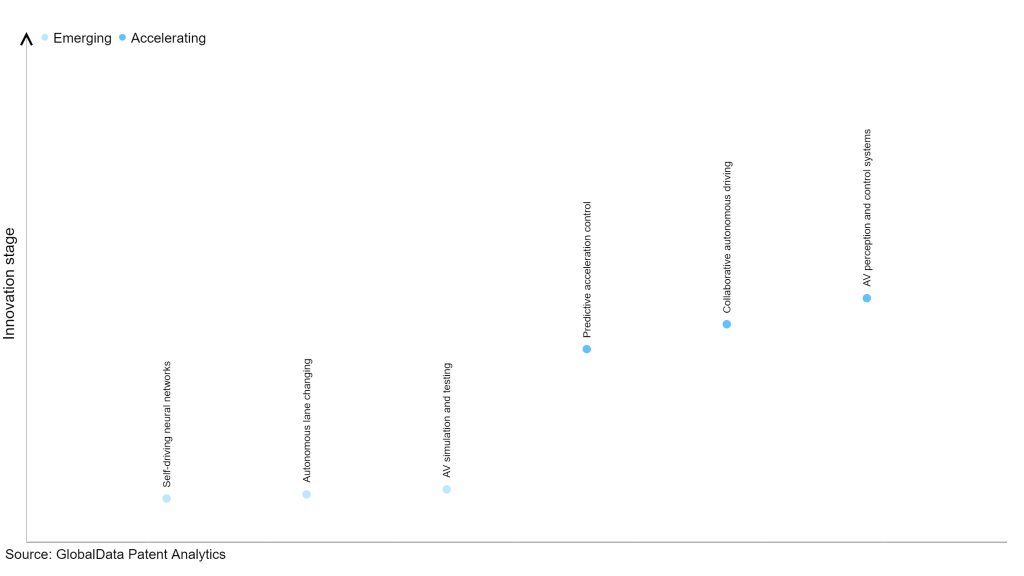The automotive industry continues to be a hotbed of patent innovation. The automotive industry is advancing moving obstacle prediction AI due to growing demand for autonomous vehicles, advancements in LiDAR and camera sensor technology, government regulations, and the availability of high-quality data. Moving obstacle prediction using artificial intelligence (AI) has applications in real-time object detection and classification, 3D scene reconstruction, and high-definition mapping, enabling autonomous vehicles to navigate safely and make informed decisions. The automotive industry is utilizing advanced technologies in moving obstacle prediction AI, including deep learning-based algorithms, optical flow-based algorithms, radar-based algorithms, and multi-sensor fusion-based algorithms. These technologies predict future trajectories of moving objects in LiDAR and camera data, with improved accuracy and robustness due to advancements in sensor technology. In the last three years alone, there have been over 720,000 patents filed and granted in the automotive industry, according to GlobalData’s report on Artificial intelligence in automotive: moving obstacle prediction AI. Buy the report here.
However, not all innovations are equal and nor do they follow a constant upward trend. Instead, their evolution takes the form of an S-shaped curve that reflects their typical lifecycle from early emergence to accelerating adoption, before finally stabilizing and reaching maturity.
Identifying where a particular innovation is on this journey, especially those that are in the emerging and accelerating stages, is essential for understanding their current level of adoption and the likely future trajectory and impact they will have.
300+ innovations will shape the automotive industry
According to GlobalData’s Technology Foresights, which plots the S-curve for the automotive industry using innovation intensity models built on over one million patents, there are 300+ innovation areas that will shape the future of the industry.
Within the emerging innovation stage, self-driving neural networks, autonomous lane changing and AV simulation and testing are disruptive technologies that are in the early stages of application and should be tracked closely. Predictive acceleration control, collaborative autonomous driving, and AV perception and control systems are some of the accelerating innovation areas, where adoption has been steadily increasing.
Innovation S-curve for artificial intelligence in the automotive industry

Moving obstacle prediction AI is a key innovation area in artificial intelligence
Moving obstacle prediction AI refers to the use of artificial intelligence technologies, such as machine learning and neural networks, to accurately predict the trajectory of moving obstacles in the path of an autonomous vehicle. By analyzing and interpreting various data inputs, such as sensor data and traffic patterns, these AI systems can generate real-time predictions to help the vehicle safely navigate the road.
GlobalData’s analysis also uncovers the companies at the forefront of each innovation area and assesses the potential reach and impact of their patenting activity across different applications and geographies. According to GlobalData, there are 680+ companies, spanning technology vendors, established automotive companies, and up-and-coming start-ups engaged in the development and application of moving obstacle prediction AI.
Key players in moving obstacle prediction AI – a disruptive innovation in the automotive industry
‘Application diversity’ measures the number of applications identified for each patent. It broadly splits companies into either ‘niche’ or ‘diversified’ innovators.
‘Geographic reach’ refers to the number of countries each patent is registered in. It reflects the breadth of geographic application intended, ranging from ‘global’ to ‘local’.
Patent volumes related to moving obstacle prediction AI
Source: GlobalData Patent Analytics
Intel is one of the leading patent filers in moving obstacle prediction AI for the automotive industry. The system uses LiDAR sensors, camera sensors, and processors to identify and track moving objects, predicting future trajectories for tasks such as object detection, obstacle avoidance, and adaptive cruise control. Nissan Motor and Alphabet are some of the other key patent filers in this field.
In terms of application diversity, Crown Equipment leads the pack, while Bayer and Magik Eye stood in the second and third positions, respectively. By means of geographic reach, Nuro held the top position, followed by Nio and Walmart.
To further understand the key themes and technologies disrupting the automotive industry, access GlobalData’s latest thematic research report on Artificial Intelligence (AI) in Automotive.
Data Insights
From

The gold standard of business intelligence.
Blending expert knowledge with cutting-edge technology, GlobalData’s unrivalled proprietary data will enable you to decode what’s happening in your market. You can make better informed decisions and gain a future-proof advantage over your competitors.



